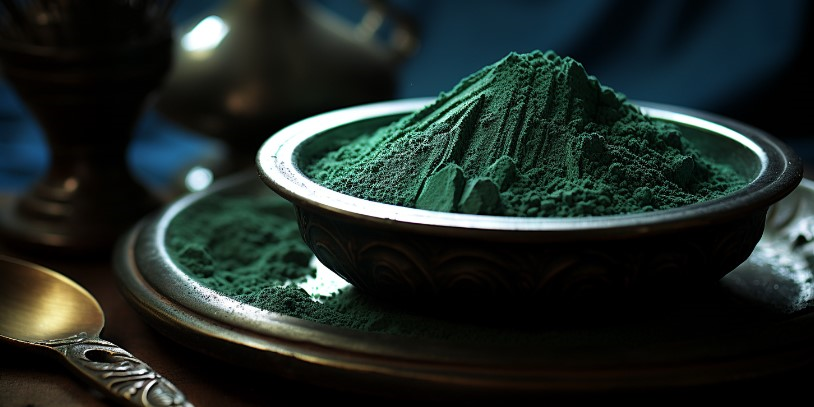スピルリナとその食品色素フィコシアニンの栄養価

スピルリナ, another name for the lower prokaryotes “arthrospira”, is a kind of naturally occurring planktic photosynthetic cyanobacteria in alkaline water (pH value is about 9.5), with a few belonging to the benthic type. Spirulina consists of a single row of cells composed of unbranched filaments, which are loosely or tightly bent in a regular spiral shape, and reproduce by breaking after growing to a certain length (spiral number).
の栄養価 スピルリナ
The nutritional value of spirulina is very high, the protein content accounts for 60% to 70% of the dry mass, and is rich in vitamin B12 and iron elements that are not common in plants, of which vitamin B12 content is 2 to 4 times the vitamin B12 content in the liver, and the iron concentration is 8 to 12 times the common plant iron.
スピルリナ can not only be used in food (functional food, additives), medicine (natural carotene) and feed industry, but also in the environment (detection, remediation), biotechnology, renewable energy and other fields have a wide range of application prospects.
In 2003, the United Nations established the Intergovernmental Institution for the Use of microalgae Spirulina to Combat Malnutrition
Use of Microalgae Spirulina Against Malnutrition, or IIMSAM, to promote the development of spirulina for the fight against hunger and malnutrition in developing countries.
フィコシアニン
Spirulina is being touted as the food of the future because it contains phycocyanin, which has anti-tumor effects. phycocyanin (PC), also known as phycocyanin, is a high-nutrient plant extract, and has the characteristics of protein, with the nature of absorption and transfer of light energy, bright blue, belongs to the intracellular protein, easily soluble in water. It can be used as a natural pigment in food and cosmetics, and can be made into fluorescent reagents, probes, tracers, etc. because of its fluorescence properties, and has been used in clinical medicine, immunology, and biology.
Antioxidant activity
Liu Qi et al. studied the protective effect of phycocyanin on oxidative damage caused by X-ray radiation in mice, and found that phycocyanin significantly increased the activities of antioxidant enzymes, superoxide dismutase and glutathione peroxidase in plasma and liver of mice after radiation, and decreased the content of reactive oxygen species in liver tissue. It is suggested that phycocyanin can reduce the oxidative damage caused by radiation by enhancing the antioxidant capacity of the body.
Antitumor activity
At present, many literatures at home and abroad have confirmed that phycocyanin has anti-tumor effects in vivo and in vitro. LI et al. proved through experiments that phycocyanin can inhibit the growth of A549 cells in vivo, inhibit the proliferation of human embryonic lung cells, and combine with all-trans-retinoic acid, retinoic acid, and retinoic acid. The synergistic effect of ATRA can decrease the mRNA level of recombinant human cystein-dependent kinase, and up-regulate the expression of cysteine proteinase-3 to induce apoptosis. When combined, ATRA can effectively reduce the toxic and side effects of ATRA on human body.
In addition, a number of experiments have confirmed that phycocyanin can inhibit the growth and proliferation of liver cancer cells SMMC-7721, laryngeal cancer cells HEp-2, melanoma cells, lung cancer cells, etc.
Immunoregulatory effect
At present, the extraction of functional peptides from phycocyanin is a major research focus. There have been many experiments to extract active peptides from spirulina and phycocyanin and master their amino acid sequences. Zeng Qiaohui prepared spirulina protein-derived biological peptides to explore the mechanism of anti-photoaging of skin. Six peptides were identified from the components with strong antioxidant and anti-photoaging activities, and among them, polypeptide 1 (sequence GMCCSR) had the best protective effect on human red blood cells, and could significantly promote the proliferation of aging skin layer fibrocytes and the production of collagen, which found a new way to develop multifunctional health food and expand the application field of phycocyanin and corn starch.
Spirulina is rich in nutrition and has many physiological functions such as anti-oxidation, anti-tumor, anti-inflammation, etc. It is a high-quality microbial protein source and has a broad prospect for development and application. However, in the process of development, the methods of breaking microalgae cells, the reagents used in extraction, separation and purification may affect the purity of phycocyanin products. In addition, the stability of phycocyanin is easily affected by temperature, pH value, light intensity, ion concentration and other factors, which seriously restricts the wide application of this pigment. Therefore, the preparation and stabilization technology of phycocyanin still need in-depth research and exploration.
Ren Shuncheng, Cao Yue, Li Linzheng, et al. Research progress of natural edible pigment phycocyanin [J]. Food Research and Development, 21, 42 (7) : 203-208. (in Chinese)
Spirulina phycocyanin supplier: www.backvita.com
Eメール:[email protected]
電話番号+86 (029) 8187 2325
